MSI X610: Supersizing the Netbook?
by Jarred Walton on October 6, 2009 10:00 PM EST- Posted in
- Laptops
X610 General Windows Performance
Quite a few people have asked for some general performance numbers in terms of Windows boot/shutdown, hibernate/resume, and sleep/wake times. These obviously vary quite a bit between runs, depending on what you've been doing on the computer. If you have a bunch of open applications, it will take longer for the system to enter sleep mode for example. We performed these tests on all of the netbooks and laptops from an empty Windows desktop, and we used the best-case result for each system.
As a side note, all of these tests benefit greatly from a fast SSD, though spending $200+ on an SSD for a $350 netbook may not be the best investment of funds. Regardless, SSDs will help application load times as well as Windows boot/hibernate/sleep times. We also need to note that the NV52 and NV58 run Windows Vista 64-bit and include 4GB RAM, which means they take noticeably longer in the hibernate/resume tests. We also included results with Windows XP 32-bit as a point of reference.
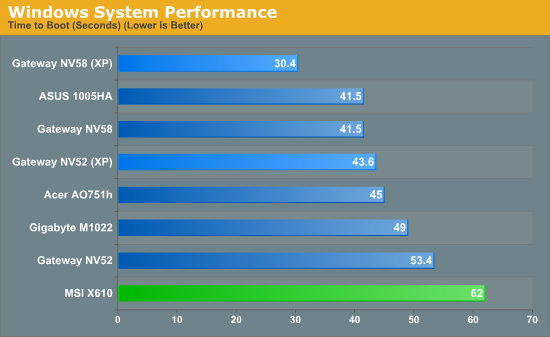
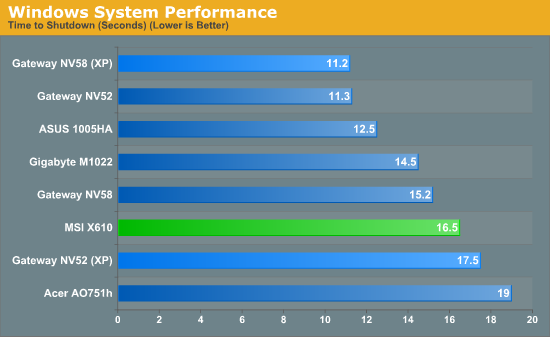
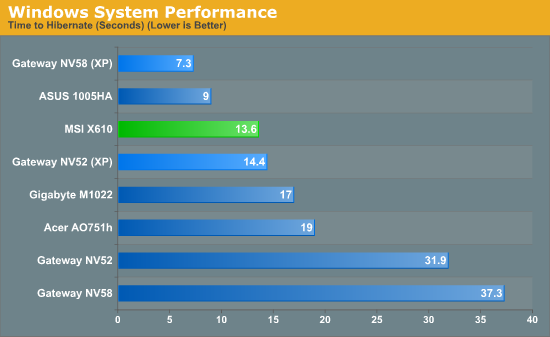
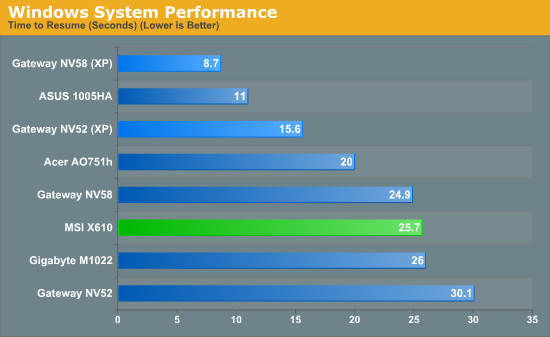
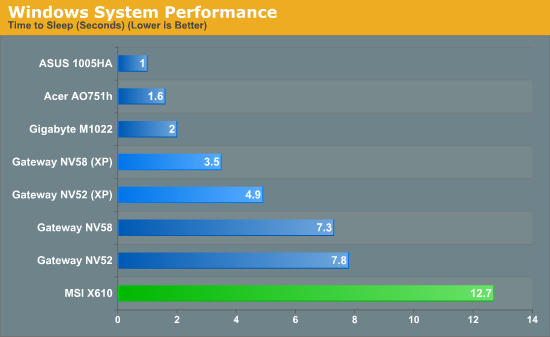

Not surprisingly, with Windows Vista and a single-core processor plus 2GB RAM, the X610 doesn't fare too well in typical OS boot/shutdown testing. It's by far the slowest laptop to start Windows, and one of the slowest for shutting down. The hibernate time is good, however, as is the wake time. One of the worst performances is in the sleep result, where it takes almost twice as long as competing netbooks/notebooks. It is also near the back of the pack when it comes to resume times.
It's worth noting that despite having a "quick boot" option enabled in the BIOS, BIOS POST times are extremely slow. The MSI X610 takes about 12.5 seconds to POST. Of course, the Gateway notebooks aren't much better, requiring about 8 seconds on the NV58 and 10 seconds on the NV52. Needless to say, the netbooks are clearly better optimized in this area, often taking only a second or two to POST. This is something that can be fixed, and frankly it should never be a problem on any current laptop. Unfortunately, manufacturers appear to be lazy in this area.










41 Comments
View All Comments
AnnonymousCoward - Wednesday, October 7, 2009 - link
1366x768 sucks.You can get a Dell 15.6" 1600x900, dual core pentium T4200, 6-cell battery, with DVD drive for $514. Or with the HD4330 for $614. The X610 is $735. The Dell weighs 1.5 pounds more, though, so you'll need to hit the gym.
Mint - Wednesday, October 7, 2009 - link
That's a pretty big "though". 4.5 lbs is just about the limit for fairly comfortable portability, and comparing it to a 6 lb notebook is ludicrous.1366x768 on a 15.6" is similar pixel size to most desktop monitors, and 1440x900 isn't that much better yet it's the highest resolution you get in a 4.5 lb notebook, AFAIK. Compare it with the top rated notebooks at this weight, like the Timeline 4810 (same res) and MacBook Pro 13" (1280x800).
AnnonymousCoward - Wednesday, October 7, 2009 - link
Comparing 4.5 pounds to 6 pounds is ludicrous? If you're that picky about weight, you'd better go for a 2 pound netbook. I would gladly take the 1.5 pounds for the high res screen and fast CPU.gstrickler - Wednesday, October 7, 2009 - link
Actually, Dell lists it at 5.54 pounds with 6 cell battery and DVD drive. It's under 6 pounds no matter how you configure it. Yes, the extra pound will make a difference, but anything under 6 pounds is very portable.Certainly, the Dell Studio 15 sounds more interesting than the MSI X610, and I would like to see how a Dell Studio 15 and/or 13" MacBook compare in performance and battery life. The Dell has the Intel X4500HD IGP standard, offers HD4570 discrete GPU as an option. The MacBooks uses the Nvidia 9400M G chipset. Both IGPs are slower than the HD4330, but they're not terrible and they use a lot less power. Both use C2D (the Dell base price has the dual core Pentium T4200, which is a C2D with less cache and slower FSB, but that's still a big step up from a single core 1.6GHz Athlon).
Mint - Thursday, October 8, 2009 - link
The market has proven both of you wrong for many years now. Why do you think Vaios and Lifebooks cost so much? Or why Apple charges more for the Air than the Pro 13"? Why do you think the M1330 was such a hit, despite costing much more than 15" Dells? Why do you think the X60/X200/X300 Thinkpads sell for so much more than 15" Thinkpads?5 lbs really is where it starts getting uncomfortable for the majority of people. 4 lbs is nice, 3 lbs is desireable. Netbooks took off when they weren't any cheaper than much faster value notebooks.
sxr7171 - Friday, October 9, 2009 - link
Ha Ha, that's what I was thinking the whole time reading this article. I'm sitting here with a 2.4lb Thinkpad X200s laughing in my head wondering about in what parallel universe would a 4.5lb laptop be considered light.This thing weighs 2.4lbs and packs a Core 2 Duo. There is no way they will allow these "netbooks" to cannibalize the sales of ultraportables hence the awkward netbook form factors as this machine. The only netbook that could even tempt me is the 1.4lb Vaio-P or actually now the Vaio-X. There could not possibly be a better machine made for surfing the internet while lying on the couch.
Also that Dell E4200 - great specs, nice 2.2lb weight.
Mint - Saturday, October 10, 2009 - link
If you're laughing at me, then what do you think about the guys that I replied to who are suggesting a 6lb notebook is light enough and comparable to this?Regardless of screen size, you can rarely get more than 1366x768 in a 4.5lb notebook for less than twice the price. No Apples, only two Dells (the 14z's), no IdeaPads (Thinkpads are way too expensive), etc.
AnnonymousCoward - Thursday, October 8, 2009 - link
I don't really understand your last sentence. I think netbooks took off since they were dirt cheap and ultra portable.Weight-aside, at 15.6", 1600x900 is a must.
Bull Dog - Wednesday, October 7, 2009 - link
I recently owned a MSI GT735 laptop and it too had the integrated GPU disabled. On the other hand, my family has a couple of old Asus laptops with 2.0GHz Turion 64 X2 CPUs and Mobility Radeon 2600 GPUs and x1250 integrated graphics and Asus gave users to option in the bios to switch between the two. And this was long before AMD was talking about doing this.Additionally the 1366x768 LCD screens are just fail. 800 vertical pixels is bad enough, now I'm supposed to step down to 768? No thank you. Why didn't MSI include AMD's dual core Athlon x2 Neo cpu instead? Probably cost reasons but it would have made the laptop far more convincing. Personally, I'm loving my HP dvz2.
dingetje - Wednesday, October 7, 2009 - link
"If MSI could keep the price close to $500 (€500)"eh, 500 Euro is about 735 US Dollar ... oops?